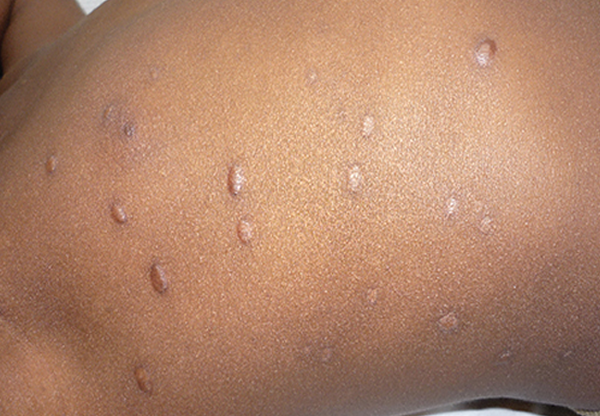This week my friend Shina celebrated his fifth year as a conqueror over chicken pox infection; he caught it from his kid who brought it home from one of her classmates in school. For my friend, it was an awful experience, something he is not forgetting in a hurry and an experience that the family is yet to forget – father and child running fever with scarring skin eruptions, serious headache,unrelenting itching and hospitalized simultaneously.
Chicken pox is a common infection in children and adults. Though commoner in children, it is usually more devastating in adults. Chicken pox is noticeable as an eruption of rashes all over the body of the affected child or adult and it is usually a once in a lifetime attack.
The chicken pox rash is described as maculopapulovesicular rash-type, an indication of the fact that the type of rash in chicken pox is a mixed-type. These include the macula rash-type looking like small reddish dots on the skin; small papules, raised type, looking like heat rashes and the numerous small blisters type with each containing a clear fluid and when these ruptured they form the common scabs of chicken pox.
How it spreads
During a bout of chickenpox, the virus (referred to as varicella at this stage) spreads through the blood to the skin. The virus also travels to nerve cells called dorsal root ganglia, which are bundles of nerves that transmit sensory information from the skin to the brain. The sensory nerves most often affected are those in the face or the trunk.
Advertisement
The virus remains inactive (latent) in these nerves for years, often for a lifetime. If the virus becomes active, however, it causes the disorder known as shingles, and the virus is then referred to as herpes zoster. It is not clear why the virus reactivates in some people and not in others. In many cases, the immune system has become impaired or suppressed from certain conditions, such as AIDS or other immunodeficient diseases, certain cancers, or certain drugs that suppress the immune system.
Mode of infection
Chicken pox, unlike the ready inference, is not contacted from chickens by humans.; it is essentially a human to human infection transmission.The mode of infection in varicella is such that when patients with a chickenpox cough or sneeze, they expel tiny droplets that carry the varicella-zoster virus (VZV). If a person who has never had chickenpox inhales these particles, the virus enters the lungs and is carried through the blood to the skin where it causes the typical rash of chickenpox.
The incubation period, which is the time between exposure to the virus and eruption of symptoms, is between 10 and 20 days. Even before the typical rash appears, the patient often develops fever, headache, swollen glands, and other flu-like symptoms. Although fevers are low grade in most children, some can reach up to 105° F.
Advertisement
The patient usually begins to feel better once the rash breaks out. One, or more tiny raised red bumps appears first, most often on the face, chest or abdomen. They become larger within a few hours and spread quickly, eventually forming small blisters on a red base that have been described as dewdrops on rose petals. Their number varies widely; some patients have only a few spots; others can develop hundreds. Each blister is filled with clear fluid that becomes cloudy in several days; it takes about four days for each blister to dry out and form a scab.
During its course, the rash itches, sometimes severely. Usually, separate crops of blisters occur over four to seven days, and the entire disease process lasts between seven and 10 days.
Risk Factors for chickenpox
Chickenpox favors no race or gender and is so contagious that few nonimmunized people escape this common disease when they are exposed to someone else with chickenpox. Between 75% and 90% of cases occur in children under 10 years of age. The disease is usually spread through sneezing, coughing, and breathing.
It can also be transmitted from direct contact with the open sores. Clothing, bedding, and objects to which the patient is exposed are not usually hazards. A patient with chickenpox can transmit the disease from about two days before the appearance of the spots to the end of the blister stage, which lasts about five to seven days. Once dry scabs form, the disease is unlikely to spread.
Complications of Chickenpox
Chickenpox rarely causes complications in healthy children, but it is not always harmless. About 14,000 people (60% children) are hospitalized and 100 patients (40% children) die from the disease each year. Vaccinations, though not readily available in our environment, could prevent many of these deaths.
Recurrence and Reactivation
Advertisement
One episode of chickenpox nearly always confers life-long immunity against a second attack; such a recurrence is possible but is very rare. Of course, the major long-term complication of varicella is the later reactivation of the herpes zoster virus and the development of shingles.
Home treatments for Chickenpox
Patients with chickenpox do not have to stay in bed unless, of course, fever and flu symptoms are severe. To relieve discomfort, a child can take paracetamol (acetaminophen), with doses determined by the doctor.
Soothing Baths
To relieve itching frequent baths are helpful, particularly when used with preparations of finely ground oatmeal. One-half to one cup of baking soda in a bath may also be helpful.
Lotions
Calamine lotion or similar over-the-counter preparations can be applied to the blisters to help dry them out and soothe the skin. This also controls the disturbing itching to a large extent.
Advertisement
Preventing Scratching
Small children may have to wear mittens, or other barrier forms so that they don’t scratch the blisters and cause a secondary infection. All patients with varicella, including adults, should have their nails trimmed short.
Chicken Vaccine
A live-virus vaccine (Varivax) produces persistent immunity against chickenpox. In advance settings, major medical organizations now recommend that all children between the ages of 18 months and adolescence who have not yet had chickenpox be vaccinated with the varicella live-virus vaccine. Data show that the vaccine can prevent chickenpox or reduce the severity of the illness even if it is used within three days, or possibly even five days, of exposure to the infection.
Advertisement
Sadly enough, in spite of its known efficacy, chicken pox vaccine is not readily available in the Nigerian medical setting. It is, however, one of the many desires that this efficacious vaccine, like many of its types, will invariably find its way into the Nigeria, thus assisting with reducing the potential agony associated with some complications of chicken pox.
Advertisement







